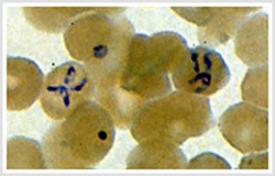Babesia

Babesiosis is an infection caused by a malaria-like parasite, also called a “piroplasm,” that infects red blood cells. Babesia microti is believed to be the most common piroplasm infecting humans, but scientists have identified over twenty piroplasms carried by ticks.
Ticks may carry only Babesia or they may be infected with both Babesia and Lyme spirochetes. People can also get babesiosis from a contaminated blood transfusion.
The first case of babesiosis was reported from Nantucket Island, Massachusetts, in 1969. Since the late1980âs, the disease has spread from the islands off the New England coast to the mainland. Cases have also been reported all across the United States, Europe, and Asia.
Symptoms
Symptoms of babesiosis are similar to those of Lyme disease but it more often starts with a high fever and chills. As the infection progresses, patients may develop fatigue, headache, drenching sweats, muscle aches, nausea, and vomiting. Babesiosis is often so mild it is not noticed but can be life-threatening to people with no spleen, the elderly, and people with weak immune systems. Complications include very low blood pressure, liver problems, severe hemolytic anemia (a breakdown of red blood cells), and kidney failure.
Diagnosis
Blood smears may be examined under a microscope to try to identify the parasite inside red blood cells, however this method is reliable only in the first two weeks of the infection. Commercial tests currently work for only three species of Babesia, and there are likely many species yet to be discovered. The PCR (polymerase chain reaction) test can detect babesia DNA in the blood. The FISH (Fluorescent In-Situ Hybridization) assay can detect the ribosomal RNA of Babesia in thin blood smears. The patientâs blood can also be tested for antibodies to Babesia. It may be necessary to run several different tests and negative results should not be used to rule out treatment.
Treatment
Babesiosis is treated with a combination of two types of anti-parasite drugs, atovaquone (Mepron, Malarone) plus an erythromycin-type drug (azithromycin, clarithromycin, or telithromycin). Long-standing infections may need to be treated for several months, and relapses sometimes occur and must be retreated.




















I’m the primary caretaker for a close family member very ill with Lyme, Bartonella, and Babesia duncani and Babesia microti. First of all, it’s possible to have more than one species of Babesia, even if you live in the West Coast. Secondly, having Babesia has made incredibly more difficult to eradicate the Lyme infection, as well as cause some serious health problems. It’s always like chasing one infection, then when that one gets better, the other gets worse…The effect of all these infections at the same time has caused disability and has had devastating effects on her quality of life and ability to have a productive and successful life. And treatment takes so much longer, years of switching different antibiotics chasing after the “infection of the day.” After all, Babesia is closely related to Malaria, both of which cause overwhelming muscular and bone pain, and high fevers, and can have significant complications – heart, lungs, kidneys.